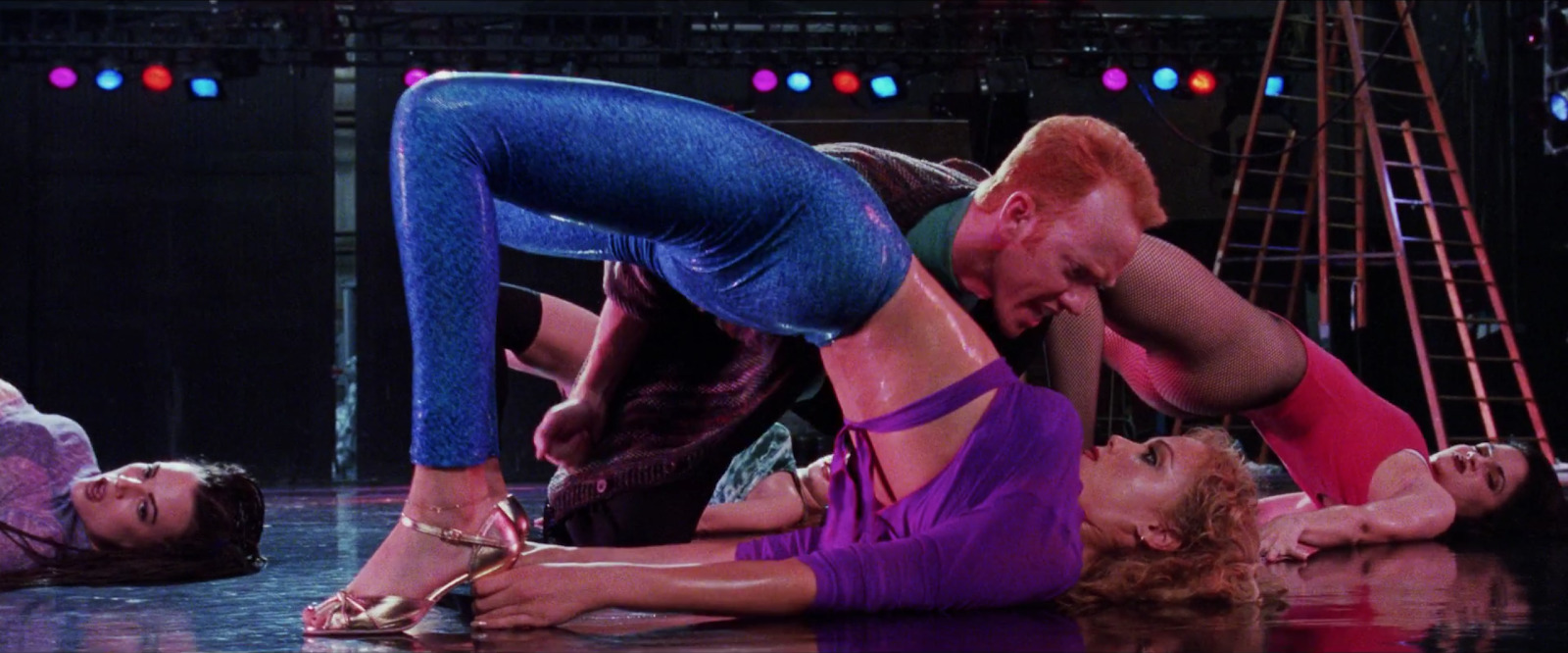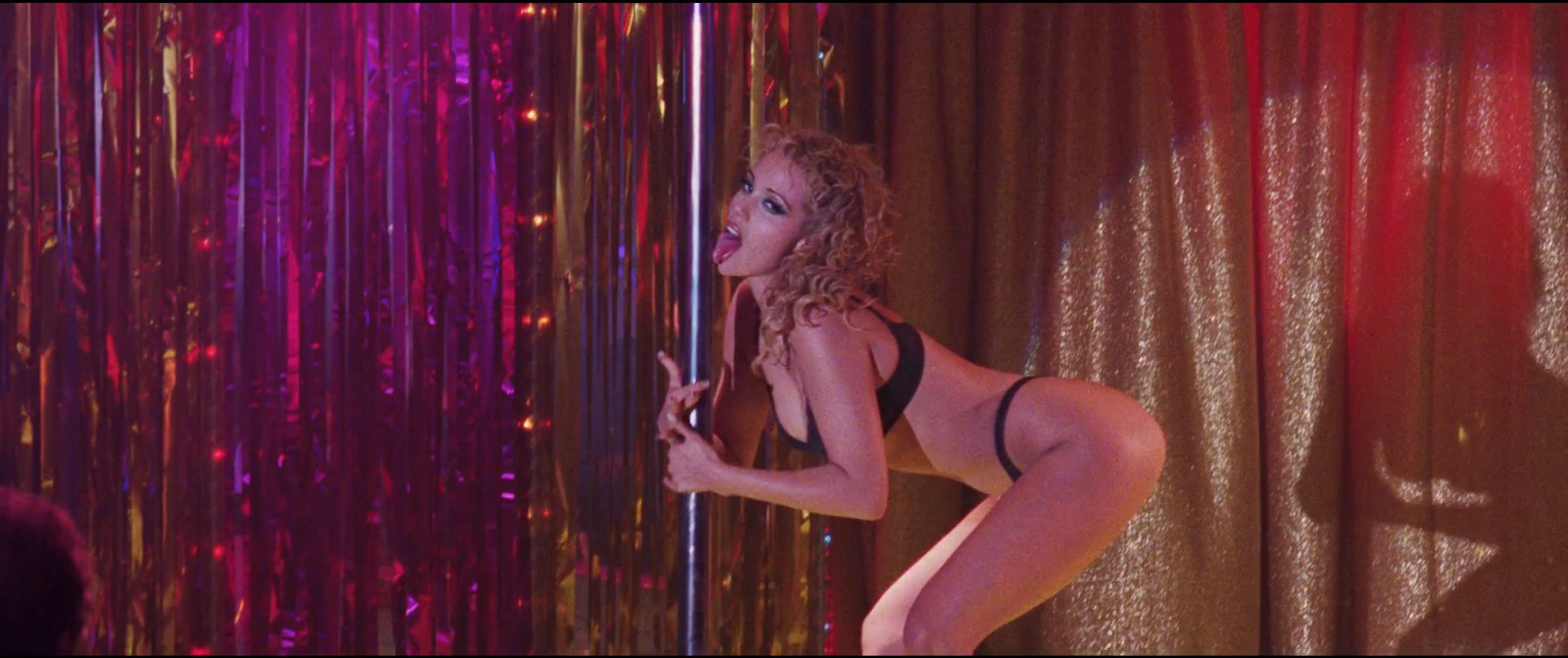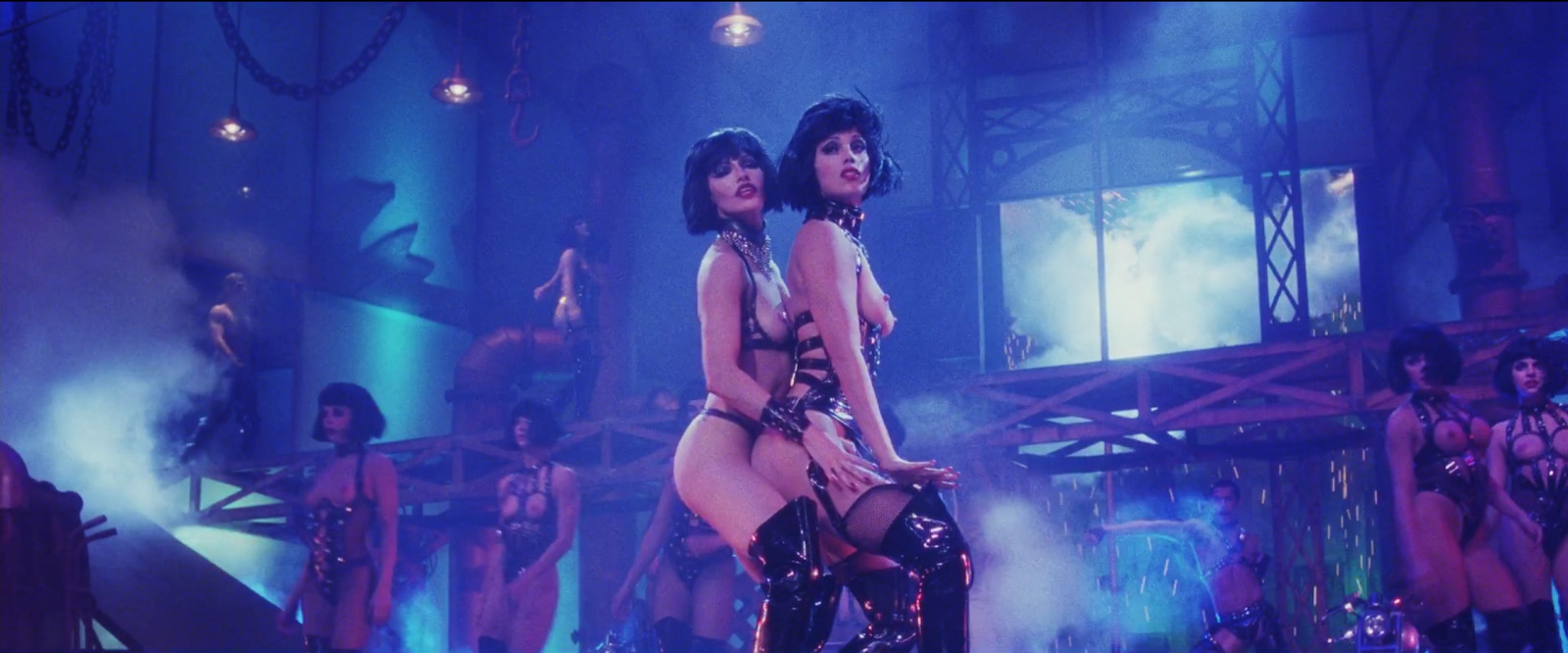There is a strip club in my hometown with a hot pink sign reading “Satin Dolls” and a marquee that has never changed. It perpetually says, “AUDITIONS DAILY.” My parents used to joke that if my dance career didn’t work out, I could always get a job at Satin Dolls. It was, of course, only ever said in jest, though still based on the premise that, if I ever actually ended up at a strip club, all my years of formal dance training would at the same time be wasted and put to use at the lowest possible tier of the western dance hierarchy. The line between “real” dancing and prostitution was thin and blurry and lingered sub rosa as I continued to take class and rehearse under teachers and choreographers who would instruct me to be sexy, but not slutty; provocative, but not cheap.
I saw Paul Verhoeven’s SHOWGIRLS years later as an adult and a professional dancer, with the only context given to me by a dance mentor that “The movie is really bad and really raunchy, but the dancing is absolutely insane.” The film’s choreography was done by the inimitable Marguerite Derricks, an enormous name in the dance industry, whose CV is that of every commercial choreographer’s envy. So I was surprised, yet sympathetic, that Nomi Malone’s (Elizabeth Berkley) chip on her shoulder is to prove that she’s a “real” dancer, when what she’s performing is actually an incredible feat of the human body. It’s frustrating that at every turn, everyone is trying to discredit her otherwise—characters in the movie and Hollywood critics alike. And for what reason? Nearly every critique of SHOWGIRLS has asked and analyzed whether this movie is good or bad, camp or trash, serious or sarcastic, sexist or feminist, and nonetheless have completely missed an allegory so obvious had they read what Nomi is physically doing on stage.
“You know what they call that useless piece of skin around a twat?”
“A woman.”
My mind keeps going back to Lin Tucci boasting to an audience of sleazeballs at Cheetah’s. The crowd laughs, and Mama Bazoom goes on to introduce the next attractive performer on the strip club’s stage, Nomi Malone—though her stage name there is Heather. (“They want class, dumb-dumb . . . They want to fuck a Heather.” Not a Nomi.”) Despite having her performance prefaced with the assertion that she’s an incompetent accessory item, Nomi bursts out from behind the curtain like she’s out to kill, with a kick to her face straight out of a can-can. She puts on a goddamn show like her paycheck depends on it (and it does). To make the job worthwhile, she must grab her audience’s attention—with sex—and hold it—with dance. Sex and dance have a lot in common. For one, they share the same instrument: body. Every person is capable of either act. They also share many of the same choreographies, communicate nonverbal human impulses and feelings, and may even require the person executing them to put on a character as in a performance. And like most things we love under capitalism, entire industries have been constructed around them with economies of their own. As women have been relegated to the sidelines of the professional job market for centuries, many have turned down these paths to survive. You can get paid to do one, or the other, or both at the same time, but the rules surrounding these occupations are plainly delineated for women, and as such have evolved to require a specific performance of femininity in a system that has been constructed by and for men.

It’s no accident that this movie works hard to hate women. Verhoeven himself has stated that his intention with SHOWGIRLS was not camp, but hyperbole, and the sardonic assertions that define his filmography reinforce SHOWGIRLS’ hyperbolic scheme of highlighting and exaggerating the economic dilemma faced by women; and what better venue than in the dance and sex industries. How much is a woman’s body worth? And when will it stop costing her? Verhoeven’s conclusion is pessimistic: no matter which rung of the social ladder she’s on, Nomi is berated, humiliated, and disrespected. If it’s not getting groped and verbally debased at Cheetah’s, then it’s getting isolated and prostituted at the Stardust. Keep in mind the decision-makers at both venues are men. Were Nomi to refuse to perform femininity in the ways it’s economically demanded of her, she would remain at the bottom of the barrel, and in the end, that’s where she ends back up.
On the contrary, in discussions with friends of mine who are actual showgirls, the paycheck is not so neatly tied to the status. Most of them were making $650-$800 for seven-to-12 shows a week, sometimes with unpaid rehearsal time. Many showgirl spectaculars also distinguish pay based on the roles of those who are more or less undressed, but surprisingly the topless women do not earn a significant amount more than those who keep on a rhinestone bra—whose dancing is more rigorous because their breasts won’t be flying around—sometimes by only $10 more per show. (It is worth noting the contracts in European shows are more lucrative than American ones.) The inter-company hierarchies, then, appear not to be a reflection of money earned but rather who is occupying the more prestigious role and for how long—a shame considering who ends up profiting the most from selling a naked woman on stage. Nomi can make $500 lap-dancing in a single night; her covetousness of Cristal’s position checks out, but only insofar as she believes becoming the namesake Goddess will legitimize her, both as a dancer and as a person.
As many forms of dance originate through an exploration and assertion of personhood, so did the showgirl. Showgirls originated in Paris around the late 1800s, presumably from the French can-can tradition that developed into chorus lines of women kicking, leaping, and jump-splitting as a cheeky revolt against women’s subjugation. The lifting of skirts meant to show off their legs and buttocks—wearing pantalettes, no less, a 19th-century crotchless undergarment—interspersed with movements and formations that mimicked military salutes and cathedrals, mocking the puritanical order of the French state. A popular act at the iconic Folies Bergère music hall, cabaret performances like the can-can evolved to include even more elaborate costumes, dance tableaus, and increased nudity, as part of evermore elaborate revues and gatherings for bohemian artists and celebrity upperclass alike. Taking this idea from his Polish-French wife Anna Held, Florenz Ziegfeld ran with it back to America, creating his eponymous Ziegfeld Girls. Removed from its original cultural context (satire of French culture), Ziegfeld and his contemporaries such as Busby Berkeley began crafting the American showgirl as an idyll of glamour and homogeneity. Although their Parisian counterparts at the Moulin Rouge, Le Lido, Folies Bérgere, and Crazy Horse perfected and consecrated the showgirl archetype, it has always been with the ethos of celebrating the female body as a work of art in and of itself, worthy of emancipating—not trapped in an advertisement, as the American way would have it. After all, Ziegfeld named his showgirls after himself.
It is with perfect knowingness that Verhoeven and writer Joe Eszterhas fixated on the showgirl. We consider her to be an effigy of the ideal woman—tall, slender, white, cisgender, unaging breasts and buttocks, thick black eyelashes and voluptuous red lips, and on display for your viewing pleasure. Adorned in jewels and feathers and sparkling undergarments, she also represents a bourgeois fantasy. To be sure, her headdresses and backpacks can weigh something like 70 pounds, and yet she floats down staircases like she’s Jesus tiptoeing across a lilypond. She is elegant, glamorous, feminine, sophisticated, passive, and quiet—all things that Nomi is not. Far too many critics have derided actress Elizabeth Berkeley’s performance of capricious Nomi, and have ignored that literally everything else in the movie is constructed to grate against her, including the very thing she aspires to be. She is not wrong to be portraying Nomi as dramatic and cantankerous, because she’s up against a cynical, greedy world.

Is a stripper, then, not unlike a showgirl? In the modern, stereotypical imagination, she often may look the same as a showgirl, with heavy makeup and a nubile body. She wears lingerie fashioned into a type of costume, though carries little in the way of accessories. Being unencumbered gives her more freedom of movement, perhaps to greater exaggerate the gestures that represent sex. She may often be alone onstage, instead of dotting a lineup of 30 other lookalikes. She must also engage in emotional labor that can most easily be described as customer service, or therapy. A triple-threat friend of mine, who recently turned to sex work as supplemental income, related the theater-to-sex-work crossover to me: “It’s all about improv and scripts and multitasking.” She noted the similarities in physically presenting herself for show, and “the psychological toll it takes to make yourself as vulnerable as possible to get work.”
The stage is also to be considered. At Cheetah’s, Nomi is given a couple minutes to thrill and titillate, competing for the audience’s attention from women who sell her same product. Framed by a low ceiling and narrow stage, Nomi explodes like a firecracker up on her platform, filling the stage, her leering audience reaching out for a chance to touch her, despite the rules of the club. In an early scene, Nomi is chastised by her boss for abandoning her post, so she begrudgingly puts on a nightie and goes back out to the club floor where the men who solicit it take any chance they get to fondle their objects without a cover charge. Availability is what this proximity suggests. On the Stardust stage, however, Nomi is untouchable. As Goddess, she doesn’t have to push the curtain aside herself—a hydraulic lift ejaculates her from a papier-mâché volcano instead. The audience came to see her, specifically, and there she is: radiant, but unobtainable. To access her would mean to clamor through the audience, climb upon the enormous proscenium stage, and then drown in a sea of toned and gold-thonged men and women dancing orgiastically. Fruitless.

A striking difference between the accounts of my showgirl friends emerged in our conversations, however—the view from the stage into the audience. When I asked about sexual misconduct in her experience dancing at Le Lido in Paris, one woman’s response was placid. Not once did she feel advanced upon by cast or crew or audience members. “I think because nudity is different in Europe,” she said. “It’s just seen as something to respect, not something just to sexualize and consume.” Families brought young kids to these shows, and the creative teams mostly comprised of women. Meanwhile, a friend in Las Vegas, though having felt safe amongst cast and crew backstage during her time in Jubilee! (the now-closed, longest running production show on the strip) stated, “We absolutely had our fair share of disgusting, repulsive people.” She recounted the theater’s house lights set specifically so the performers could report offenders to security. “For something being such a classy, tasteful show, compared to the burlesque ones that I’ve done as well, people still act the same around boobs.”
Undoubtedly, SHOWGIRLS would fail under Verhoeven’s project had it not been set in the American capital of excess, fabulous Las Vegas, a place of few winners and mostly losers, which sells the fantasy that there’s room for everyone at the top so long as one is willing to take the risk. In reality, this can’t be true in a city that has almost completely monopolized itself. Nomi’s driver as she hitchhikes into Vegas prods her with this doctrine anyway:
“You gamble?”
“No.”
“Well you gotta gamble if you’re gonna win.”
“I’m gonna win.”
Foreshadowing what’s to come, this interaction is immediately followed by a big win and then complete loss at the slot machines. Nomi powers on, often kicking and screaming, for the chance to be a winner, the chance to be ideal, legitimate, because the losers get booed off stage, or slip on loose beads, or raped. Well, those who lose didn’t play by the rules, right? No one is meant to get to the top very easily, and no one is meant to stay at the top for very long: this is the most crucial principle of SHOWGIRLS. A woman’s body is just a disposable pawn in the Luxor-lit pyramid scheme, no matter how alluring or idyllic or authentic the top may seem. It’s with the understanding of this demoralizing, capitalistic process that Cristal grants Nomi her well wishes in the end, despite their former feud; Cristal knows that Nomi was just playing by the rules, the rules written by men in overpriced suits. “You are a whore, darlin’,” Cristal taunts. “We all are. We take the cash, we cash the check, we show ‘em what they wanna see.”
















Comments